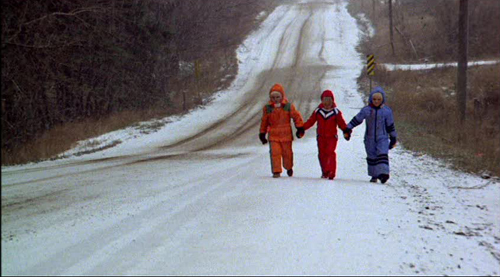Blog Post 4
Bohang Liu
What is interesting about The Brood is that it is a perfect
mixture of horror, family melodrama and science fiction. During the film, I
tried to focus on the theme of the Accursed Child, and who it was in the film.
After a close examination, I realized that there is more than one possibility.
In Sobchack’s reading, figures “have the power to disrupt the relation of
context to sign and reorient not only the discursive event but the system
itself which will never be the same afterwards” (Sobchack 148). The Accursed
Child is that figure.
At one
angle, Candice represents the accursed Child in a family melodrama. Along the
words of Sobchack, the father in melodrama is clueless. Candice’s father knows
little of what’s happening to Candice’s mother. “When Mother is the ‘absent
one’, these dads are given license to indulge themselves in feeling and
ineptitude” (Sobchack 155). This in fact holds true as Frank only takes action
in the end by killing Nola to save his daughter.
The Brood represents the science
fiction starchild. Sobchack mentions, “Nonetheless, in both genres, the figure
of the child was first introduced as embodying a suspect miscegenation of alien
and human characteristics “(Sobchack 157). The Brood is a clear embodiment, as
the creatures are asexual, toothless, and given birth by Nola
parthenogenetically. Still however, the Brood acts on the rage of Nola and not
themselves.
Nola represents the Accursed Child
in the horror element. She represents the repressed matriarchy and her rage
causes the Broods to kills her own parents who mistreated and neglected
her. In one scene, she breaks open the
embryo of the Brood and starts licking the alien child. This scene is important
because it relates back to Sobchack’s idea how a figure like the Accursed Child
can change the system itself. The movie viewer realizes and accepts the event
such as giving birth the Brood is possible in the context of the film. The
viewers later on that Candice has a pair of small bumps growing on her arm; something
her mother experienced as well. This implies that Candice can also give birth
to the Broods.
The Accursed Child can also be
examined through the gender of the child. Unlike films with a male children,
who in most part are in competition with their fathers in horror films like The
Shining, The Brood uses female characters, in this case, the father such as
Frank, feel little in competition with his daughter, rather he feels its his
duty to protect her. Nola’s father, who did the opposite, is faced with the
wrath of his own daughter along with Nola’s mother. The Oedipus complex does
not exist in this film. In this particular film, the matriarchy is the aggressor,
and the weak patriarchy fails to protect. This is in sharp contrast with other
horror films with a male accursed child. At the end, however, we see patriarchy
reestablishing itself by saving its child.
Works Cited
Vivian Sobchack. “Bringing it All Back Home: Family Economy and Generic Exchange.” The Dread
of Difference: Gender and the Horror Film. Barry Keith Grant, Ed. Austin: University of Texas Press, 1996.



No comments:
Post a Comment